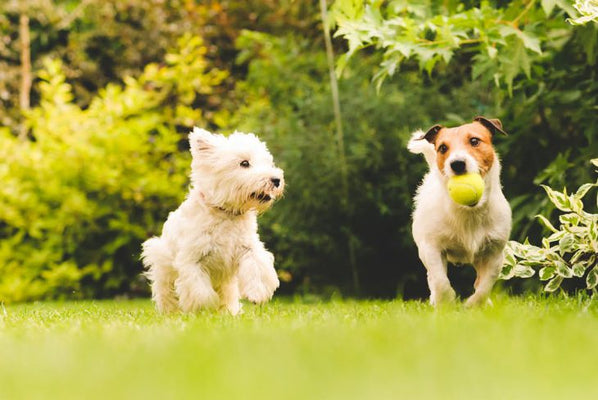Dogs are naturally active, athletic and social, which is why it is commonly assumed that dog runs are the ideal place for them. In many cases, they are; for many dogs, going to the dog run is their favourite part of the week. However, while the environment dog runs provide certainly is great for both physical and mental activity, it is also a lot trickier than many dog owners anticipate.
Taking your dog to the local dog run may seem like a simple and convenient activity, but it can in fact put you in several unforeseen situations. Some trainers actually suggest you don’t take your dog to a park unless you know them inside out and are familiar with proper dog run etiquette, because it otherwise might cause repercussions you are unprepared to deal with.
The Risks When Going To Singapore Dog Runs
It is important for every responsible owner to realise that dog runs pose quite a few risks, the obvious ones being health risks like fleas found on other dogs. Other than that, there is also the possibility of injury – even if you think your dog is friendly and calm it doesn’t mean that other dogs will behave in a similar manner. Dog runs also aren’t a great idea for pets with anxiety or those that easily become stressed, since bullying, fighting and intimidation can occur at any time, the situation might soon become too difficult to deal with.
Furthermore, it is important to note that everyone’s definition of acceptable dog behaviour is different; while you may be okay with your dog jumping on you and licking you, others might classify it as behaviour that crosses a line. Some people may come up to your dog to pet him or her, but others might be afraid of larger dogs. In essence, there are several things that constitute dog run etiquette and you might want to familiarise yourself with before taking your dog to one.
Why is Dog Run Etiquette Important?
Other than the fact that lack of etiquette might annoy others or physically harm your dog, poor knowledge and mannerisms at the dog run can actually lead to more long-lasting problems. A simple rough play or brawl between dogs can trigger long-term fear and aggression problems that can be rather tricky to alleviate.
In case of a dog that has not been fully trained, you might find that a single incident at the dog run leads to ruined training and reactivity problems with your pet. For your dog’s physical and mental health as well as for those of other people’s dogs, it is essential that you familiarise yourself with dog run etiquette and accordingly train your dog.
Things That Can Go Wrong at the Dog Run
You might be surprised at the number of unacceptable things that happen at dog runs in Singapore – mostly because many of them are commonly not even seen as problems per se. Here are a few behaviours and activities you need to be watchful of with respect to the dogs and the dog owners present at the dog run:
Dogs running up to other dogs – While your dog might just be eager to play and therefore may run up to another dog, it is important to remember that not all dogs are open to interacting with strangers, just like humans. When one dog runs up to another without warning, it can cause fear, anxiety and reactive aggression, all of which can become difficult to mitigate.
Invading others’ space – Some dogs love to jump on people or on other dogs, or even mount them or sniff them. Some don’t like to share their toys while others might think it’s okay to casually steal others’ toys. These differences in dog behaviour and preferences – not unlike those in humans – can become uncomfortable for certain dogs and their owners.
Forceful and play – Many dogs don’t understand that others might not want to play with them, or might not be physically as strong as them. This leads to dogs crowding in on other dogs, trampling them or even biting them a little too hard while intending to play. However, a dog’s good intentions don’t always translate into the consequences, which may include emotionally traumatised and physically hurt dogs, and disgruntled owners.
How to Avoid Common Problems At Dog Runs
Dog run etiquette primarily constitutes proper preparation before going, knowing what to allow and what to avoid, and being equipped to handle a tricky situation. Here are a few of the most important things all dog owners must know when taking their pet to the dog run:
Gradual introduction to the park – Your dog has never been to a dog run. Does it really seem suitable to take them there, unleash them immediately and let them be? Certainly not. Familiarity with dog runs must be built slowly and in a way that you maintain thorough control. At first, take your dog out but keep them on a leash and keep them away from packs of dogs playing. Slowly begin to move to the main area and eventually unleash them, but always keep a close watch.
Exercise before going to the dog run – This might seem strange, but it is especially important for dogs that stay indoors and have lots of built-up energy that comes out in a gush when they are unleashed. To calm your dog down and to keep them from bothering others at the dog run, it is important to release at least some of the energy beforehand. This can simply be done by walking to the dog run or engaging in play with toys before unleashing at the park.
Know the signs of anxiety – Not only should you be familiar with your own dog’s signs of anxiety, but should also be able to tell if your dog is making another dog uncomfortable. Anxious, scared or stressed out behaviourmight include pacing, backing up, cowering, and wincing. If you see any of these, intervene immediately.
Know the signs of aggression – This is also extremely important to make sure you can avoid a fight before it starts. Snarling, growling or barking at other dogs are all negative signs. Running towards another dog may be both aggressive and friendly, but should be trained against in both cases.
Come-when-called training – The one habit that needs to be absolutely ingrained in your dog’s behaviour is knowing their name and coming when they’re called, regardless of what they’re doing. It is the simplest yet the most effective way to keep them away from an aggressive pack as well as to keep them from bothering another dog. Unfortunately, you might find that coming when called is not as easy at the dog run as it is at home. Luckily, you can build the habit by keeping an eye on your dog and making sure you call them every now and then in the middle of play, give them a treat when they come, praise them and then let them go off to play again.
Proper bite inhibition training – Most dogs that have been raised with puppies for the first 8-12 weeks of their lives know not to bite too hard while playing, but some don’t. If your puppy’s bite inhibition is poor, it is not advisable to let them interact with others until you’ve perfected the training yourself or with the help of a trainer.
Know when to reprimand – Your dog probably knows what you sound like when you disapprove. If they engage in any unwanted behaviour like scaring another dog or getting too close to other people against their will, make sure you reprimand them and let them know what they’ve done is wrong; bullying is not cute and your pet needs to learn that. Simply removing your dog from the situation might not actually fix the behaviour.
Use toys correctly – If you are taking your pet to the dog run for the first time, we advise you avoid taking all toys except the usual ball to play fetch with; not all dogs like sharing and some actually might crowd in and steal others’ toys. If you do bring toys, make sure you keep them with yourself only and use them to engage the dog in playing with you for when playing with other dogs or people does not seem appropriate.
Unleash your dog – While leashing is advisable for initial introduction and warming-up to an area, You might consider unleashing your dog if you are certain your dog is not aggressive to other dogs. When one dog in an area is on a leash while others are roaming free, it can cause anxiety, fear and helplessness in the leashed dogs, while triggering intimidating behaviour in the unleashed ones, potentially leading to fights. If another person’s dog is on a leash, make sure you keep your own pet away from them.
Remove harnesses and spike collars – We cannot stress this enough: you must be considerate about other dogs in the area. If your dog’s harness or collar is likely to hurt another dog during play, make sure you remove it before letting them free. Dogs naturally nibble or playfully bite around the neck and it is important to make sure they don’t inadvertently get hurt by your dog’s accessories.
Stay away from packs in general – It might be okay to let your dog play with another dog provided that the recipient and their owner are okay with it and the play is healthy and friendly, but avoiding large packs is a good way to avoid problems. You don’t know the temperament of all dogs and might not always be able to avoid problems.
Know which dogs to take to the dog run – Puppies that are under 12 weeks of age, dogs that are in heat as well as those who are pregnant are all poor candidates for the dog run. It is also unethical to take an unvaccinated pet to the park, since this endangers both your pet and the pets of others.
Don’t get distracted – It is important to remember that dog runs are for dogs to socialize, not for people. It is imperative to make sure you keep an eye on your puppy, stay close to them and take responsibility for them, instead of getting distracted by conversations with other dog owners or with activities like using your phone.
Clean up after your dog, always – This may be a no brainer but is absolutely essential to remember. Even though you are outdoors and there are park cleaning facilities, it is important to pick up your dog’s poop. Ideally, you should know the signs of impending excretion and take your dog somewhere that is appropriate, but mistakes are common when outdoors. That should not keep you from cleaning up after your dog and making sure you leave the space clean for other dogs and owners!
Are You Ready For A Dog Run?
As a dog owner, you might be surprised at how difficult dog runs can get – aren’t they supposed to be convenient and fun?! The important thing to understand is that the temperaments of dogs differ like just those of humans. Some people are introverted and like to stay by themselves while others are loud and outgoing; some are easily scared and anxious while others are bold and risk-taking. And all of these different kinds of people don’t always mix well. The same holds true for dogs; they are all different, as are their definitions of ‘normal’ and ‘acceptable’.
While dog runs can be challenging, therefore, being familiar with the necessary training and etiquette is the key to making them the best part of your dog’s and your own daily or weekly routine. It takes some work, but the result is worth it!
